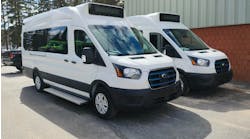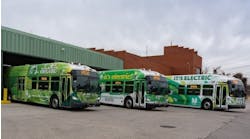Doors opened Oct. 13 to the world’s largest showcase for the public transportation industry – the American Public Transportation Association’s (APTA) Expo. Public transportation is an innovative industry that serves a progressively crucial role in ensuring America’s economic competitiveness. Public transit is a $58 billion industry that contributes significantly to the American economy.
“Predictable, long-term investment in public transportation is critical to making communities economically competitive,” said APTA President and CEO Michael Melaniphy. “Investment in public transportation drives growth. It attracts development, increases property values along its corridors, and creates transit-oriented communities.”
Currently, the industry directly employs about 400,000 individuals and for each $1 billion invested in public transportation, 50,700 jobs are supported and created. It also enables millions of Americans to reach work affordably, with work commutes making up nearly 60 percent of trips on public transportation. And, the value of this industry has never been more evident. In 2013, 10.7 billion trips were taken on public transit – the highest ridership in 57 years.
"Public transportation offers more than just mobility, it also shapes communities," continued Melaniphy. “Our industry is about the future, and public transit is a crucial part of the solution to the nation's economic, energy, and environmental challenge."
In addition to its economic impact, public transportation provides a vital link between residents and their communities, offering both mobility and freedom. America’s two largest generations, millennials and baby boomers, are increasingly turning to public transit to suit their unique needs. Millennials, empowered by smartphones and other devices using near-field technologies, want multimodal options, like public transit, that allow for social interaction and digital connectivity. Meanwhile, baby boomers are returning to urban cores and are looking to public transit to maintain flexibility and independence in their travel. However, for residents of small urban and rural areas, access to public transit still needs to be greatly expanded. Nearly two-thirds of all residents in these communities have few transportation options.
Public transit also plays a role in the U.S. becoming energy independent and reducing carbon emissions. And, the industry continues to explore innovative solutions to further improve its impact on our environment.
- Public transportation already saves 37 million metric tons of carbon dioxide (CO2) annually.
- In 2014, 41.3 percent of public transit buses in the U.S. used alternative fuels or hybrid technology. This is a dramatic increase from 13.3 percent just ten years ago, and demonstrates the industry’s leadership in supporting innovative clean technologies and fuels, including biofuels, hydrogen fuel cells, and hybrid vehicles.
- Some public transportation systems also are investing in propulsion technologies in rail to capture and harness wasted energy to help power transit systems, while others are exploring electrifying their commuter rail lines to replace diesel trains with electric trains.
Technology is also rapidly advancing the way public transit agencies operate and support passenger needs including swift and continuous exchanges of information, safety innovations and increased operational efficiencies. For example, the rise of smartphones and near-field technology has opened the door for more exact trip planning, vehicle tracking and diagnostic monitoring, as well as new options in fare collection. Meanwhile, software-enhanced interior and exterior surveillance systems can continuously detect suspicious activities and automatically relay information to control centers and safety personnel. Finally, technologies like positive train control (PTC) will keep passengers and workers safe by separating trains, enforcing train speed limits, and controlling train movement in areas of track obstructions.


